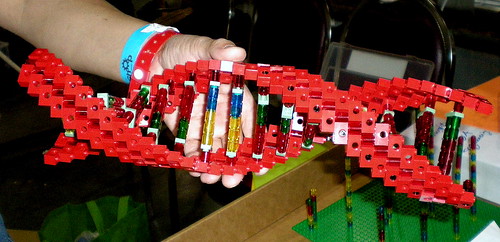
Friday, June 14, 2013
DNA patent ruling
Here's some DNA. I'm not sure who built this, as this was at a public display and turns up in several people's photo streams. Anyway, you might ask why post this today, as I just posted a model of DNA in my last post. Well, this gives me a chance to write about the ruling from the US Supreme Court in the case of Association for Molecular Pathology v. Myriad Genetics, Inc. As I understand it, Myriad held a series of patents, and some were upheld while others were struck down. To understand this case, we have to start with a description of transcription/translation. DNA resides in the nucleus, and protein synthesis takes place at the ribosome outside the nucleus. In order to get the information from the DNA to the ribosome, a copy is made, the complementary strand of RNA. So, for instance, let's say there is a DNA strand that goes GCGCAAGC. The complementary strand of messenger RNA is CGCGTTCG (C's match with G's, G's match with C's, T's match with A's). But, let's go a little further. About 98% of the human genome is not used for making proteins. When this non-coding DNA (sometimes called 'junk DNA', but it does actually have important regulatory function) comes in the middle of a DNA sequence, it is called an intron. So the unwanted parts are removed. So, for instance, our CGCGTTCG strand could be trimmed down to just CGCGCG, and this mature mRNA would code for the protein Arg-Ala (groups of three RNA bases are called 'codons', and code for different amino acids). Okay, back to Myriad Genetics. They found that a mutation in the code for a particular protein is associated with certain kinds of breast cancer. So, in our example the healthy cell has DNA GCGCAAGC, which leads to mRNA CGCGTTCG, which is modified to mature mRNA CGCGCG, which codes for protein Arg-Ala. Let's say the potentially cancerous cell has DNA CCGCAAGC, which leads to mRNA GGCGTTCG, which is modified to mature mRNA GGCGCG, and this would code for protein Gly-Ala, and let's say this protein is associated with cancer. Myriad came up with a test for the presence of this mutation. Their test involved creating a shortened form of DNA with the introns removed, called complementary DNA. In our example this would be CCGCGC (note it is missing the AA from above). They take mRNA from the patient, and see if it binds to this complementary DNA. If it does, it indicates the presence of a mutation that could lead to cancer. They then took out patents on the process of comparing the mRNA to their complementary DNA, the sequence in the complementary DNA (CCGCGC), and also the sequence in the initial DNA (CGCGCAAGC). What the Supreme Court ruled yesterday is that the third type of patent is invalid, as the sequence of DNA in the living cell (either healthy or cancerous), is a 'product of nature'. That is, Myriad did not invent it, so they cannot patent it. OTOH, the complementary DNA is not naturally existing, and so therefor may be patented. It is also valid to patent a novel method involving this complementary DNA. So it was a mixed ruling, but IMO a correct one. The human genome is still there available for anyone to do research without fear of being sued for patent infringement, but there is still incentive for companies to produce new types of tests that they can protect with patents.


Subscribe to:
Post Comments (Atom)
No comments:
Post a Comment